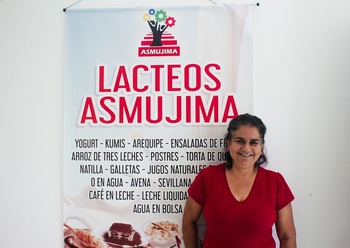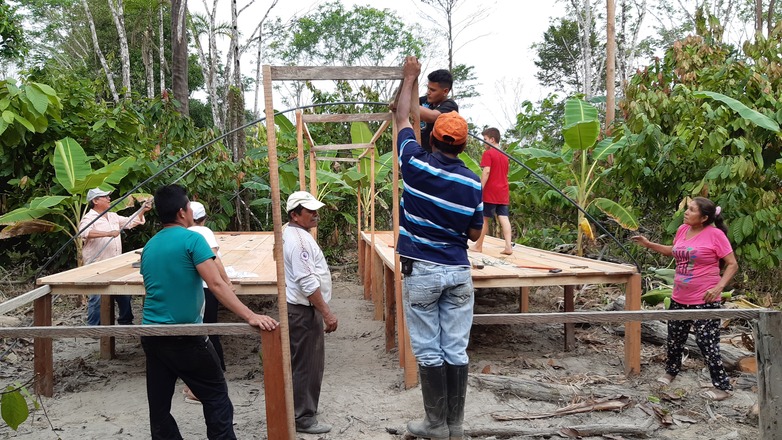Protecting natural resources in the former conflict regions of Colombia
Project description
Title: Environmental regional planning in areas affected by conflict in Colombia – AmPaz
Commissioned by: German Federal Ministry for Economic Cooperation and Development (BMZ)
Country: Colombia
Lead executing agency: Colombian Presidential Agency for International Cooperation
Overall term: 2018 to 2020

Context
Only two other countries in the world have greater biodiversity than Colombia. The country’s highly bio-diverse and forest-rich regions have been heavily affected by more than 60 years of ongoing internal con-flict. In these regions, illegal land-use practices and large-scale deforestation are a widespread problem. The social consequences particularly affect women, young people, indigenous and Afro-Colombian minorities, who are often the victims of violence, expropriation or displacement.
In 2016, a peace agreement was signed with the most significant guerrilla group, the ‘Revolutionary Armed Forces of Colombia’ (Fuerzas). In 2016, a peace agreement was signed with the most significant guerrilla group, the ‘Revolutionary Armed Forces of Colombia’ (Fuerzas Armadas Revolucionarias de Colombia, FARC). The first item of this accord involves extensive agricultural reform. It thus opened up the opportunity to redesign the post-conflict regions, taking account of environmental and social aspects in the process. However, implementing the peace process and the territorial development programmes developed to this end has proven to be a major challenge.
The objective is to enable effective interplay between the environment, income-generating measures and social participation. However, the municipalities often lack the capacity for action to ensure a uniform design of planning processes and adapt them to the needs of the population. Only a few promising examples of environmentally friendly income-generating alternatives actually exist, and the financial and technical support that would be necessary to implement them is also unavailable.
Objective
Territorial planning and pro-development measures in post-conflict regions take into account the conservation and sustainable use of natural resources while taking account of the specific needs of population groups affected by the conflict.

Approach
Working in the thematic triangle of ‘environment-territory-peace’, the AmPaz project promotes land-use options that incorporate environmental aspects and are consistent with development measures. The project is active in six municipalities in the post-conflict regions of the Meta and Caquetá departments and is divided into four fields of activity:
The first field of activity aims to strengthen local and regional stakeholders in a bid to foster a uniform approach to developmentally and environmentally oriented regional planning. The views and opinions of local stakeholders with regard to the use of natural resources are taken into account in regional planning and anchored in the municipalities’ development plans.
In the second field of activity, the project focuses on developing and implementing green business models together with cooperatives. These offer the local population alternative sources of income that make sustainable use of natural resources.
The project’s third field of activity enables access to green financing instruments for sustainable business models and forms of employment in cooperation with local and national financiers.
In the fourth field of activity, crosscutting training courses and development measures strengthen the skills of key stakeholders and foster networking and exchanges of knowledge.
Results
In the first field of activity, AmPaz supported the Environment Ministry in integrating the population into the participatory process for updating the regional planning components. These form the basis for the local land-use plans and benefit some 40,000 people.
In the second field of activity, milk, rubber and cocoa producers developed green business models that use natural resources sustainably and increase the productivity of the businesses. Around 600 people benefit from this.
In the third field of activity, the project developed and piloted green agricultural credits with three financial institutions. With this, it supports the Environment Ministry and the development bank FINAGRO, in the development of a countrywide ‘green’ credit strategy. Moreover, 450 smallscale producers attended a course on financial themes where they learned to identify investments and apply for green credits. 55 per cent of the participants were women.
Thanks to the communication skills training from field of activity four, sixty reporters now report continuously and from firsthand experience about the transformation of their home communities.
As a consequence of the emergency situation caused by COVID-19, AmPaz implemented economic recovery measures in the project region. Through additional productivity and quality improvement measures, the project supported more than 1,600 producers and their families, who can now charge higher sales prices.
Latest update: September 2020
